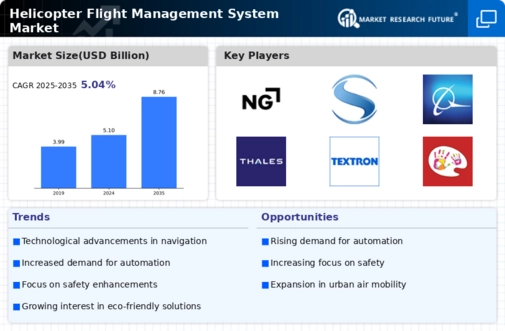The competitive landscape of the Helicopter Flight Management System Market is characterized by a dynamic interplay of technological advancements, strategic partnerships, and a growing emphasis on safety and efficiency within the aviation industry.
As helicopter operations demand increased precision and reliability, flight management systems have become pivotal in ensuring optimized flight paths, enhancing situational awareness, and providing comprehensive navigation solutions.
Key players in this market are leveraging innovative technologies such as artificial intelligence and automation to improve system capabilities and offering customized solutions to meet diverse customer needs across various sectors, including emergency services, military operations, and commercial aviation.
The increasing focus on modernizing air fleet operations and integrating advanced avionics systems is spurring competitive growth, with companies actively engaged in product development and enhancement initiatives to maintain their foothold in this evolving market.
Northrop Grumman stands out prominently in the Helicopter Flight Management System Market, recognized for its robust technological solutions and comprehensive portfolio.
The company's flight management systems are built on decades of expertise in aerospace and defense, granting them a competitive edge in terms of reliability and performance.
Their advanced systems incorporate state-of-the-art software and hardware that facilitate optimal flight navigation, including improved algorithms for real-time data processing, which play a crucial role during both routine operations and emergency scenarios.
Northrop Grumman's commitment to research and development fuels continuous innovation, allowing them to tailor their offerings to meet the specific demands of various helicopter platforms.
Furthermore, their solid reputation for partnering with military and governmental organizations positions them favorably within the market, enhancing their visibility and credibility in delivering complex helicopter operations.
Safran is another influential player within the Helicopter Flight Management System Market, known for its specialization in high-tech equipment and aviation solutions.
The company leverages years of experience in the aerospace sector and combines it with its cutting-edge technology to develop efficient and reliable flight management systems. Safran's systems are designed to enhance operational efficiency and safety, reducing pilot workload while optimizing flight maneuvers through superior navigation tools.
Their innovative solutions are tailored to accommodate a wide range of helicopter models and customers, spanning military and civilian applications.
With a strong emphasis on strategic collaborations and continuous improvement, Safran stays at the forefront of market developments, continuously adapting to shifting customer requirements and maintaining a competitive advantage in the landscape of helicopter flight management systems.

























Leave a Comment